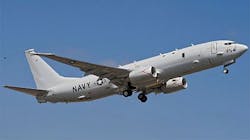Boeing P-8A ASW aircraft production ramps-up with $2 billion contract for 13 more planes
PATUXENT RIVER NAS, Md., 1 Aug. 2013. Aircraft designers at the Boeing Co. Defense, Space & Security segment in Seattle are making plans to build an additional 13 P-8A Poseidon long-range maritime patrol jets for the U.S. Navy under terms of a $2 billion contract modification announced late Wednesday.
Officials of the Naval Air Systems Command at Patuxent River Naval Air Station, Md., announced the contract modification to Boeing (NYSE:BA), which involves low-rate initial production (LRIP lot-4 models of the P-8. The contract includes long-lead parts for 16 more P-8A full-rate production lot-1 aircraft.
The P-8 is a modified Boeing 737-800 single-aisle passenger jetliner modified for the long-range maritime patrol and anti-submarine warfare (ASW) mission. The P-8, which will replace the Navy's ageing fleet of P-3 Orion four-engine turboprop maritime patrol jets, will carry sonobuoys, acoustic surveillance gear, special torpedoes designed to drop from high altitudes, and other sophisticated ASW equipment.
Boeing received a $1.9 billion contract last fall to build 11 P-8A Poseidon jets. Wednesday's contract for 13 more of the long-range aircraft will bring the Navy's fleet of P-8As to 37. Navy leaders plan to buy a total of 117 P-8 aircraft.
In addition to its ASW gear, the P-8A will carry anti-ship missiles, and will be equipped with the Raytheon APY-10 multi-mission surface search radar. The P-8 will replace the Navy's P-3 Orion aircraft, a version of the Lockheed L-188 Electra passenger turboprop that was half a century ago.
The P-8 is designed to work together with the Northrop Grumman MQ-4C Triton broad-area maritime surveillance (BAMS) unmanned aerial vehicle (UAV), which is based on the Global Hawk long-range surveillance UAV.
As the manned and unmanned aircraft work as a team, the P-8A will handle high-altitude maritime surveillance over large areas. When the P-8 acquires a contact surface ship or suspected submarine, it can call in the MQ-4C UAV to maintain contact with the target while the P-8 attends to other duties.
The P-8 will be able to lay fields of sonobuoys from high altitudes and monitor sonar returns from the sonobuoy field itself, or hand over monitoring to an MQ-4C UAV on station nearby.
The P-A also will be equipped with flying torpedoes -- specially modified versions of the Navy's Mark 54 lightweight torpedo with wings and other flight-control surfaces -- that can be deployed from altitudes as high as 30,000 feet.
The ability to drop torpedoes to attack targets from high altitudes will enable the P-8 aircraft to avoid time- and fuel-wasting descents and ascents back to optimum surveillance altitudes as it performs its mission.
On the contract modification announced Wednesday, Boeing will do the work in Seattle; Baltimore; Greenlawn, N.Y.; Cambridge, England; Rockford, Ill.; North Amityville, N.Y.; and other locations, and should be finished by April 2016.
For more information contact Boeing Defense, Space & Security online at www.boeing.com, or Naval Air Systems Command at www.navair.navy.mil.

